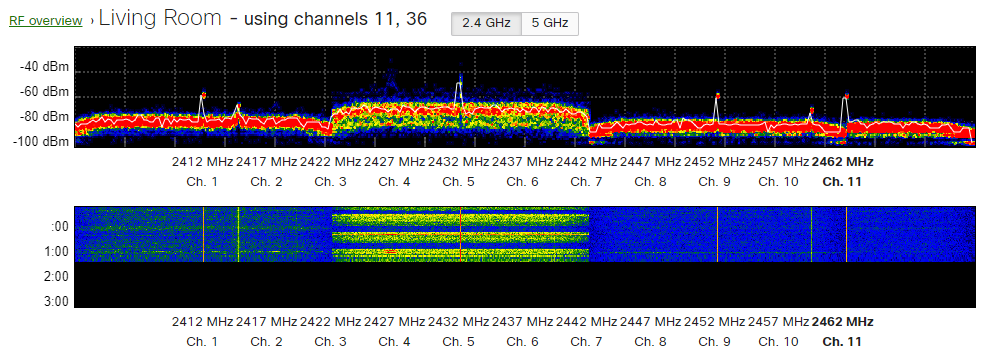
I had seen a twitter thread from Nolan Herring last August for this exact issue, but never pursued it further. At the same time I had checked with coworkers who also received MR33s around the same time as myself. They saw the exact same spikes regardless of their actual channel plan or RF environment.
Meraki MR33 access point spectrogram shows incorrect data.
I first noticed this shortly after I got my AP up and running. Above you’ll see the spectrogram for 2.4 GHz. At the time the screenshot was taken I was using channels 11 and 36.
I have pretty clear spectrum most of the time. There’s no way channels 1, 5, 9, and 11 had noise like that.
Below is a screenshot from my Ekahau Sidekick. Channel 1 in this instance is used by a separate Meraki device I use for remote access into the office. Channel 11, my home network, has near zero use.

I found similar results on the 5 GHz band, but not as pronounced. I’m running channel 36 at 80 MHz at home, and channel 140 on my remote access VPN. Again, no neighbors registering at this particular time.


The Meraki MR33 shows strange spikes throughout the spectrogram on both 2.4 GHz and 5 GHz.
Finally in June 2019 I opened a case with Meraki support. After several back and forth communications I send them the screenshots above from the MR33 and my Ekahau Sidekick. On July 11th, 2019 the support engineer I was working with replied that:
We do the see the same RF spectrum for MR33. I will be submitting a bug report to the Internal Team and I will update you once I have any information from them.
Meraki Technical Support Engineer
I’ve not yet seen any further updates from Meraki, nor have I seen anything in new code release notes. It does feel good to have the vendor reproduce the error. I suspect it’s some kind of internal noise simply overpowering the signal processing, but as I don’t think that model AP is ‘current’ any longer I doubt it will ever be fully fixed.